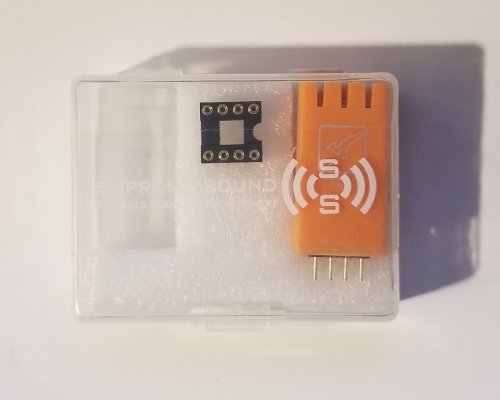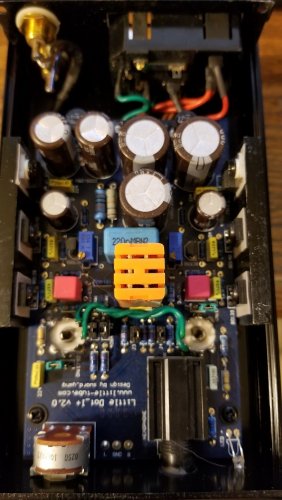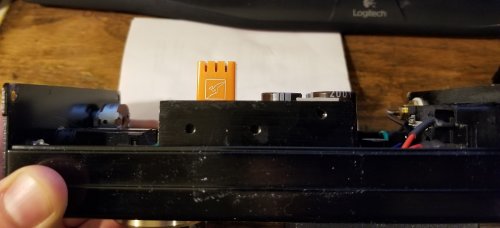You are using an out of date browser. It may not display this or other websites correctly.
You should upgrade or use an alternative browser.
You should upgrade or use an alternative browser.
Reviews by GotNoRice
Filters
Show only:
Loading…
GotNoRice
100+ Head-Fier
Pros: Amazing clarity and energy to the sound, with the soft tube touch also.
Cons: Requires 3 OpAmps.
I've had the Maverick Audio TubeMagic D2 DAC for a while and I've been going back and forth between using LM4562 Opamps and the OPA627 Opamps that came pre-upgraded with this unit (each two single OPA627 OpAmps on an adapter board to create a dual opamp). Each had it's pros and cons but neither really seemed to be giving me everything I wanted. The OPA627 seemed more smooth, but almost too smooth, to the point of lacking texture in some cases. The LM4562 had more of the texture that I preferred, but can also be just a bit harsh, especially for long listening sessions. The tube output, using a Sylvania 5670W tube, did help, but only so much.

I've had good results with Burson Audio OpAmps in other devices, so I decided to try some Burson Audio V6 OpAmps in the D2. Since the TubeMagic D2 DAC uses 3 OpAmps, I decided to mix it up a bit, with one V6 Vivid Dual and two V6 Classic Dual Opamps, each type in a different stage of course.

Installing them was somewhat tricky, due to the fact that they are so tall, while also being fairly wide at the bottom. Each Burson Opamp comes with an optional riser that can help keep the OpAmp above the surrounding components, but that also makes the already tall OpAmps even taller.

Here you can see all the OpAmps installed using risers. The single V6 Vivid is just short enough to allow the top cover to be installed. Unfortunately, due to the design of the sockets, the V6 Classics in the middle sit just a tiny bit higher, and that tiny extra bit of height was enough to prevent the cover from closing properly. My only other good choice was to try and install the V6 Classics without the risers. That made them awfully cozy with some of the surrounding components, but seems to not be a problem. That made them shorter and the cover is able to close correctly with them installed.



Listening tests were done using my Little-Dot I+ Headphone Amplifier, using Sylvania 408A tubes, powering a set of Beyerdynamic DT770-Pro 80-Ohm headphones.

During my tests, the difference sounded fairly subtle. They definitely have texture, more like the LM4562 than the OPA627, but they also were not fatiguing at all. Vocals were vibrant and and the mid-bass was very energetic. When I really noticed the difference though, was when I took them out. The OPA627 and LM4562 OpAmps just seemed dull compared to before. Not terrible, but there was clearly something missing.
Both the Tube output and the Normal output seemed to benefit from the upgrade, but I still prefer the Tube output overall, as was the case with the previous OpAmps that I used.
Hopefully there will be no long-term issues with the V6 Classic Opamps being in contact with some of the surrounding components, but so far there are no issues. It turned out to be a very worthwhile upgrade.
I've had good results with Burson Audio OpAmps in other devices, so I decided to try some Burson Audio V6 OpAmps in the D2. Since the TubeMagic D2 DAC uses 3 OpAmps, I decided to mix it up a bit, with one V6 Vivid Dual and two V6 Classic Dual Opamps, each type in a different stage of course.
Installing them was somewhat tricky, due to the fact that they are so tall, while also being fairly wide at the bottom. Each Burson Opamp comes with an optional riser that can help keep the OpAmp above the surrounding components, but that also makes the already tall OpAmps even taller.
Here you can see all the OpAmps installed using risers. The single V6 Vivid is just short enough to allow the top cover to be installed. Unfortunately, due to the design of the sockets, the V6 Classics in the middle sit just a tiny bit higher, and that tiny extra bit of height was enough to prevent the cover from closing properly. My only other good choice was to try and install the V6 Classics without the risers. That made them awfully cozy with some of the surrounding components, but seems to not be a problem. That made them shorter and the cover is able to close correctly with them installed.
Listening tests were done using my Little-Dot I+ Headphone Amplifier, using Sylvania 408A tubes, powering a set of Beyerdynamic DT770-Pro 80-Ohm headphones.
During my tests, the difference sounded fairly subtle. They definitely have texture, more like the LM4562 than the OPA627, but they also were not fatiguing at all. Vocals were vibrant and and the mid-bass was very energetic. When I really noticed the difference though, was when I took them out. The OPA627 and LM4562 OpAmps just seemed dull compared to before. Not terrible, but there was clearly something missing.
Both the Tube output and the Normal output seemed to benefit from the upgrade, but I still prefer the Tube output overall, as was the case with the previous OpAmps that I used.
Hopefully there will be no long-term issues with the V6 Classic Opamps being in contact with some of the surrounding components, but so far there are no issues. It turned out to be a very worthwhile upgrade.
John Massaria
try sparkos OPA or/ and the OPA1611 an amazing chip
GotNoRice
100+ Head-Fier
Pros: Able to give sound that is smooth while also retaining the texture of the music. Very energetic sound.
Cons: Large case requires adapters or other creative solutions in order to fit within certain devices.
History:
A while back, when deciding which Opamp to use in my Little-Dot I+ Headphone amplifier, I had narrowed down my favorite opamps to the LM4562 (dual opamp) and the OPA627 (two single OPA627 opamps on an adapter board). The LM4562 had a texture to the sound that I enjoyed, but was also just a little bit harsh. The OPA627 was very smooth, but almost too smooth, and lacking texture. I generally preferred the LM4562. The Burson V6 Classic Dual seemed to be the next step up, but I was not actually sure what to expect.
My system:
-Maverick Audio TubeMagic D2 DAC (Sylvania 5654W tube & 3x LM4562 Opamp)
-Little-Dot I+ (Sylvania "Gold Brand" 408A tubes)
-Beyerdynamic DT770-Pro 80ohm / Sony MDR-XB700 24ohm headphones.
First impressions:
The Burson V6 Classic Opamps come in wonderful packaging, also containing an optional riser. The riser was very helpful in keeping the Burson Opamp up above the other components on the circuitry on the Little-Dot I+ (at least with my PCB version).
Case with one Opamp and one riser removed:

When playing the first song after installing the Burson V6 Classic, what I noticed immediately was that the sound just seemed a bit more energetic, especially vocals, and making for some very punchy midbass. Thinking back to my previous comparison between opamps, this Burson seems to have both the smoothness of the OPA627 while having even more texture than the LM4562; truly a best of both worlds, and more.
Unfortunately, the V6 Opamp is so large that the bottom of the case for the Little-Dot I+ won’t close with it installed (and the riser only makes it worse). As I have seen in other reviews, some have simply cut a hole in the bottom of the case, others have used custom extensions/adapters to use the Opamp at an angle. I will have to decide which route I want to take, but for now, I will simply use my Little-Dot I+ on its side.



Extended listening:
First, I went through some Hard Rock and Metal using my Beyerdynamic DT770-Pro 80ohm headphones. I use many of these songs as my benchmark to test vocals, to see if the vocals can retain their clarity and energy even in the middle of a very “busy” song. The Burson V6 Classic had no problems passing this test. There was no accentuated treble either, and listening fatigue was not an issue even after a long session.
Next, I swapped over to my Sony MDR-XB700 24ohm headphones. These have very large drivers, and at 24 ohms the Little-Dot I+ can put out almost a full watt. I use this for listening to music with very deep bass, including some Pop, Hard Rock, EDM and Dubstep. Bass can have a texture of its own, and I have observed differences between Opamps in this regard before. Using the Burson V6 Classic, I did not notice anything special about the deep bass. But at least, it didn’t seem to be doing anything worse than past Opamps that I have tried, and even bass-heavy songs still have plenty of midrange and midbass that clearly does benefit.
Conclusion:
My experience with this Burson V6 Classic Dual Opamp has been fantastic. Everything about my listening experience was either equal to, or better than, every past opamp that I have tried.
The tall size does make installation in devices such as a Little-Dot I+ a challenge without getting creative, but in my opinion, It’s worth it.
Ultimately, I want to try using these in my DAC also.
A while back, when deciding which Opamp to use in my Little-Dot I+ Headphone amplifier, I had narrowed down my favorite opamps to the LM4562 (dual opamp) and the OPA627 (two single OPA627 opamps on an adapter board). The LM4562 had a texture to the sound that I enjoyed, but was also just a little bit harsh. The OPA627 was very smooth, but almost too smooth, and lacking texture. I generally preferred the LM4562. The Burson V6 Classic Dual seemed to be the next step up, but I was not actually sure what to expect.
My system:
-Maverick Audio TubeMagic D2 DAC (Sylvania 5654W tube & 3x LM4562 Opamp)
-Little-Dot I+ (Sylvania "Gold Brand" 408A tubes)
-Beyerdynamic DT770-Pro 80ohm / Sony MDR-XB700 24ohm headphones.
First impressions:
The Burson V6 Classic Opamps come in wonderful packaging, also containing an optional riser. The riser was very helpful in keeping the Burson Opamp up above the other components on the circuitry on the Little-Dot I+ (at least with my PCB version).
Case with one Opamp and one riser removed:

When playing the first song after installing the Burson V6 Classic, what I noticed immediately was that the sound just seemed a bit more energetic, especially vocals, and making for some very punchy midbass. Thinking back to my previous comparison between opamps, this Burson seems to have both the smoothness of the OPA627 while having even more texture than the LM4562; truly a best of both worlds, and more.
Unfortunately, the V6 Opamp is so large that the bottom of the case for the Little-Dot I+ won’t close with it installed (and the riser only makes it worse). As I have seen in other reviews, some have simply cut a hole in the bottom of the case, others have used custom extensions/adapters to use the Opamp at an angle. I will have to decide which route I want to take, but for now, I will simply use my Little-Dot I+ on its side.



Extended listening:
First, I went through some Hard Rock and Metal using my Beyerdynamic DT770-Pro 80ohm headphones. I use many of these songs as my benchmark to test vocals, to see if the vocals can retain their clarity and energy even in the middle of a very “busy” song. The Burson V6 Classic had no problems passing this test. There was no accentuated treble either, and listening fatigue was not an issue even after a long session.
Next, I swapped over to my Sony MDR-XB700 24ohm headphones. These have very large drivers, and at 24 ohms the Little-Dot I+ can put out almost a full watt. I use this for listening to music with very deep bass, including some Pop, Hard Rock, EDM and Dubstep. Bass can have a texture of its own, and I have observed differences between Opamps in this regard before. Using the Burson V6 Classic, I did not notice anything special about the deep bass. But at least, it didn’t seem to be doing anything worse than past Opamps that I have tried, and even bass-heavy songs still have plenty of midrange and midbass that clearly does benefit.
Conclusion:
My experience with this Burson V6 Classic Dual Opamp has been fantastic. Everything about my listening experience was either equal to, or better than, every past opamp that I have tried.
The tall size does make installation in devices such as a Little-Dot I+ a challenge without getting creative, but in my opinion, It’s worth it.
Ultimately, I want to try using these in my DAC also.



